Batteries for marine use, whether engine start or house batteries (Deep Cycle), can mean the difference between blissful boating or an exercise in crisis management. Evan Honore introduces the technology and make-up of marine batteries systems, the objective being to assist boat owners in making informed decisions, understanding what is happening to batteries on board, knowing when to consult a specialist marine electrician, and what makes up the various battery technologies to effects the life and performance.
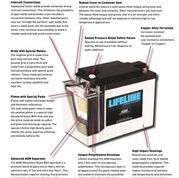
What many recognise as a typical battery is called a lead acid battery. This is a plastic box that has a number of plates constructed into cell groups inside. These plates are generally made of lead with metal additives to promote strength and electron flow and a coating of lead oxide paste. The solution that is surrounding the plates is called electrolyte, generally made up of 35% sulphuric acid and 65% distilled water. The chemical reaction that takes place causes electrons to be produced thus releasing some of the energy stored in the battery. A battery only stores energy that has been put into it.
It does not produce on it’ s own. An engine starting battery commonly provides very high current for a short discharge period resulting in approximately 1% of the capacity being discharged, easily recovered by the charging system. Conventional charging systems, such as an engine driven alternator, provide a charge for marine engine starting batteries.
Basic Principles – Flooded Lead Acid Batteries
This section deals with the basic principles of the battery, the figures quoted generally apply to conventional ‘ wet’ or ‘ flooded’ batteries commonly used in marine applications. Many of the common problems are experienced with house batteries as these are the ones doing a lot of work. In electrical systems, volts is the electrical pressure and the electrical flow is the amps. The amount of flow is dependent upon the restrictions in the electrical circuit called resistance. The battery simply stores power.
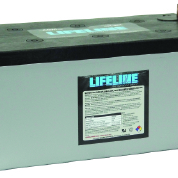
If the battery is not charged at the right pressure (volts) or does not receive adequate charge because of the amount of current flow or the duration of charge, then it will not be able to deliver if required. It is worth noting that small variations in charging voltages have significant effects. A half charged battery has a terminal voltage of 12.2 volts. If we look at the difference between a charging system supplying 13.8 volts to the battery or 14.5 volts, the difference in electrical pressure pushing the charge current into the battery is in the first instance 1.6 volts and in the second instance is 2.3 volts. Whilst the actual difference is only 0.7 volts this represents a 43% higher charging voltage which will roughly represent the increase in charge current or capacity gained by the battery in a given charging period. Batteries and electrical systems can be likened to water tanks and water flow. The battery is the storage tank. It has a positive pressure outlet and a negative pressure return and the electrical system operates on a closed piping system. The alternator is simply an electrical pump which is used to refill the tank.
Charging the Battery
The alternator or battery charger is an electricity producing pump which generally has a voltage (pressure) restricting device on it called a regulator. To force electrical current back into the battery the voltage of the alternator or battery charger needs to be higher than the voltage of the battery. If the voltage is too low (at the battery) then not enough storage capacity will be achieved. If the voltage is too high then the battery may be damaged through overcharging. As with water tanks, the more full (or charged) the battery is the higher the back pressure. So with a fixed inward voltage and a growing back pressure the current flow into the tank steadily tapers downwards.
Special Characteristics of Batteries
Ventilation
When the battery nears a full charge condition bubbles of hydrogen and oxygen gas are produced which leak out of the battery by way of the vent plugs. This condition is normal but does require that flooded batteries are placed in a ventilated space. Some types of batteries do not produce any gas in normal working conditions, but if overcharged even these batteries will produce gas which can be dangerous meaning that ventilation is required for all battery types.
Safety
When a battery is being recharged dangerous gases (hydrogen and oxygen) are given off by the battery. More gas is produced at higher charge voltages. If ignited by a mere spark, this mixture will explode and can cause serious injury. Most at risk are the eyes so when working around or on the batteries, particularly during or after charging, always wear safety glasses.
Float Charge
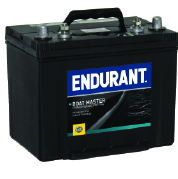
Once the battery is charged, a longer battery life will be achieved if the charging voltage being applied by the alternator is reduced. A continued application of the normal recharge voltage results in deterioration of the internals of the battery preventing it from holding or delivering as much capacity. The reduction of the charging voltage, once the battery is charged, is called putting it on “float”. However, even a float charge can cause corrosion of the positive plates. Some marine battery chargers completely automatically turn off, monitoring the battery sate of charge and turning back on when required. Continuous float charging of engine starting batteries is not recommended as a reduction in life is inevitable.
Sulphation
If the battery is left flat or partially charged it develops a condition called Sulphation which inhibits the current flow into the battery during recharge. This condition can be likened to a build up of “sludge” in a water tank which effectively increases the back pressure which
results in less inward flow. Severe Sulphation can render a battery useless, reducing its capacity and making it unable to be fully charged.
Maintenance
The action of charging also causes the loss of water in most batteries and has to be replaced by topping up with clean distilled water. In the case of sealed batteries, if over charged, the loss of this water will still take place and permanently damage the battery as it cannot be replaced. Terminals should be kept clean and dry.
Maintaining Capacity
The action of charging and discharging the battery causes a change in the consistency of the electrolyte. When the battery is charged, acid is produced which is more dense or heavy than the electrolyte. When the battery is discharged water is produced which is lighter than the electrolyte. As a result the water floats on the top of the heavier acid. This is called “Acid Stratification”. When the battery is recharged to near full charge the resulting higher voltage causes production of the bubbles of hydrogen and oxygen which gradually move up through the electrolyte and out through the vent plugs in the top of each cell.
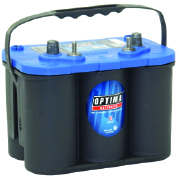
The movement of these bubbles up through the electrolyte has the effect of mixing the acid. This mixing process is vital to achieve long battery life as Acid Stratification increases the incidence of Sulphation. When house batteries are subjected to normal charge/discharge use, unless subjected to long engine running times or shore power charging, effective DC-DC charging (or similar), the battery is rarely fully charged. The lead sulphate found in the plates (a normal condition) will ‘ harden’ over a period of time and is difficult if not impossible to remove. This results in a loss of capacity. This loss of capacity is progressive and cumulative and will result in reduced performance and life.
Depth of Discharge
If the battery is repeatedly drained to low levels of capacity the life will be less than if it is only partially discharged. This is called the depth of discharge or DoD. The greater the DoD, the shorter the life.
Temperature Compensation
When a battery is heated it requires lower charging voltage to receive the correct charging current. Accordingly a lower charge voltage should be applied as the temperature increases. This is called temperature compensation.
Battery Environment
As a chemical device, the activity inside the battery is affected by temperature. A common cause of battery failure is grid corrosion. This is the gradual deterioration of the lead based grid/plate that is corroded by the electro-chemical action. The rate of this corrosion is increased with the temperature surrounding the battery when the battery is being recharged. From this it is quite clear that house batteries in particular will last longer if installed in a cool place as opposed to common engine room installations, even the temperature compensated charging is applied.
The difference between Automotive & Marine batteries

Batteries fitted to cars and trucks are required to provide a very high cranking current to start the engine for a short time. After this is achieved the battery simply receives charge from the alternator. Only rarely is the battery required to deliver power for any duration of time. To achieve high cranking current output, the manufacturer uses very thin plates made in such a way that the acid has good access to the active material which is producing the current. If you place this type of battery into a marine environment, particularly to provide long and deep discharge periods the battery is likely to have a short life.
Marine batteries fall into two categories. Engine Starting and House Bank, of Deep Cycle batteries. The Engine Start type is of similar construction to an automotive battery. Quality marine specific products such as the Hella Endurant Boat Master series are manufactured in such a way to be highly resistant to damage caused by shock and vibration. In general terms, a quality marine battery will be of a more robust construction to automotive batteries that tend to be built to a price rather than a standard. When a battery is regularly charged and discharged, this causes deterioration of the positive plate. Deep cycle batteries, in simple terms have a thicker plate and a more dense active material which is able to withstand the pressures of this type of use.
Plates/Capacity – A popular misconception
As described above, plate thickness varies widely and therefore cannot be used as an indication of capacity. To give an example, a high performance engine starting battery with 22 plates per cell is available in New Zealand and is approximately 65 ampere hours in capacity, whilst another battery of 350 ampere hours has only 15 plates per cell. When specifying a battery it is important that the application is considered. For example, when marine engine starting is required then the MCA (Marine Cold Cranking Amps) rating is an indication of the battery’ s ability to start an engine, whilst for auxiliary loads and deep cycle applications ampere hour capacity is what you need to consider.
Alternative Lead Acid Battery Types
Marine batteries are broadly broken into two categories. The most common is the ‘ wet’ or ‘ flooded’ technology. This is the conventional type which in principle is largely unchanged from the original design going back over the last 100 years. However significant gains in efficiency, charge acceptance, reduced maintenance requirements and increase energy output have been achieved due to technology over time. Of more recent times the Valve Regulated Lead Acid (VRLA) type, often called “sealed”has been introduced. Some confusion may exist over this type of product as often the battery is a flooded type but maintenance free, not requiring a top up of electrolyte. There may also be some confusion over “Gelled Electrolyte” and the alternative VRLA “Absorbed Electrolyte” or “Absorbed Glass Mat” (AGM) technologies. The following passages will hopefully provide some clarity.
Flooded Batteries
Most of the information provided in the previous paragraphs pertains to ‘ flooded’ batteries. However within this range two types of constructions exist. The most common is the ‘ Flat Plate’ construction. This is available in maintainable and ‘ maintenance free’ configurations. In simple terms the battery manufacturer alters the alloys used to manufacture the battery so that only very small amounts of Hydrogen and Oxygen gas are produced during charging. This results in minimal water consumption over the life of the battery. However it should be noted that if tipped over this battery will sometimes leak.
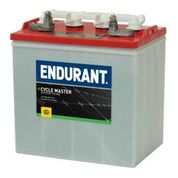
In larger deep cycle installations where high levels of storage capacity are required, batteries come in the form of 2 volt cells connected in series to make up the required voltage. The reason for this is simply for ease of handling. In the two volt cell form ‘ Tubular Positive’ batteries are available. This involves a different method of construction of the positive plate of the cell, which is very robust and resistant to deterioration caused by deep and regular cycling. This product is generally manufactured in Europe and carries a high quality price point, however over the life, dependent upon application and care and maintenance programs, can represent excellent value.
Valve Regulated Batteries
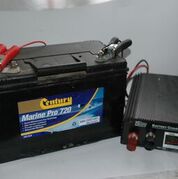
Years ago it was discovered that by changing the internal construction of the battery and maintaining a positive pressure (3 to 5 psi) inside the battery, it was possible to get any Hydrogen or Oxygen gas that may be produced during charging to recombine internally. This resulted in completely sealed battery designs, allowing the battery to be installed without fear of acid spillage, emission of corrosive gas and almost zero maintenance. In some cases this type of product can be installed on its side and will work whilst submerged without the production of any chlorine gas which is often produced when a flooded battery comes in contact with salt water.
As briefly mention above, within the VRLA group two different types of technology exist. The most commonly used in a marine environment is the Gelled Electrolyte. Provided it is well manufactured, this type of product provides excellent cycling characteristics with all the benefits of a valve regulated product. The electrolyte inside is in a “jelly” form so no spillage is possible. The second type of VRLA uses a material like blotting paper made from glass fibre to retain the electrolyte. This method also removes any loose electrolyte from sloshing around which may spill or leak. Independent tests tend to demonstrate that Gelled Electrolyte type batteries are better suited to a cycling (charge flat) application like marine house batteries than the AGM type, although premium quality products from AGM manufacturers such as the Lifeline brand provide highly competitive and proven technologies. In reality the VRLA battery is not everything to everyone and have had some reliability problems in the past. Some of these problems can be blamed on factors not provided by the battery itself but in truth the VRLA battery is more “sensitive” than the tried and proven flooded battery.
This delicacy means that unless the battery is manufactured to perfection and well cared for through an accurate charging program it could provide a shorter life than a cheaper alternative flooded product. To provide an example: If a vessel suffered alternator regulator failure during a passage and the batteries were over charged, in the case of flooded batteries, the lost water would be topped up and would suffer little damage (provided the regulator was replaced within a reasonable time). In the case of VRLA batteries (depending upon running time) it is possible, if not likely that the batteries would require replacement along with the regulator.
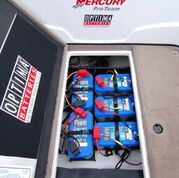
Now this is not to say that VRLA batteries do not provide a good or even the best option in some instances but these options need to be explored, ideally with a respected marine electrician who can discuss all of the options rather than just one technology. Quality AGM batteries are very robust and due to the tight compacted internal construction perform very well under in harsh vibration where traditional flooded batteries may shed their active material through vibration off the plates, gradually losing capacity. AGM brands such as Optima, Lifeline and Hella Endurant are specified successfully into many demanding commercial applications for both engine starting and deep cycle applications where they consistently outlast their traditional flooded equivalents. As with any choice of equipment and systems onboard, not all Gelled or AGM products are created equally. The old adage of ‘ you get what you pay for’ certainly rings true with battery technology. Nationwide service, support, company reputation, inquiring as to the country of origin and company manufacturing the product helps build a complete picture of the quality and reliability on offer.
BATTERY TIPS
- A battery stores charge it does not “Manufacture” it.
- Insufficient charging voltage will cause poor battery performance.
- Insufficient charging voltage will cause short battery life.
- Excessive charging voltage will cause short battery life.
- Leaving a battery partially charged will reduce life and performance.
- Periodically batteries need to be fully charged to maximise life and performance.
- Engine Starting Batteries are required to deliver high current for a short time. If this type of battery is subjected to many cycles of charge/discharge a short lifeis likely.
- Deep Cycle Batteries are designed for a charge/discharge usage but can start engines in emergencies.
- Life is reduced by a warm temperature environment.
- Not all Valve Regulated Batteries are the same.
- Valve Regulated Batteries have good features and benefits but are more “Delicate” than flooded batteries.




